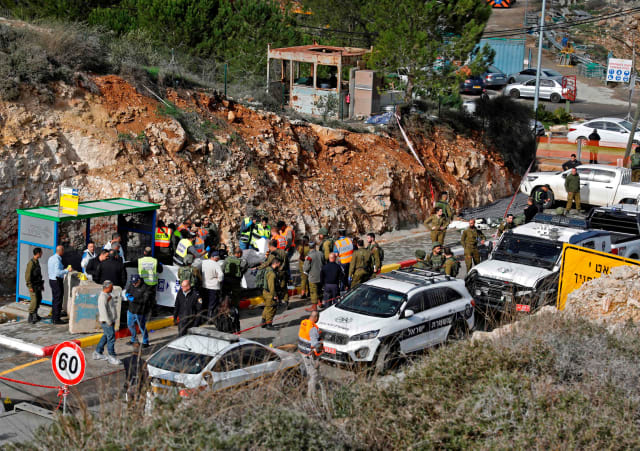Analysis/West Bank Spirals Into Violence as Hamas Ups Efforts to Orchestrate Attacks
تحليل سياسي من الهآررتس لهاريل عاموس: الضفة الغربية تواجه تصاعداً في عمليات العنف وحماس تسعى لإدارة الهجمات
Amos Harel/Haaretz/December 13/18
Return of deadly West Bank attack could harm Israeli security coordination with Abbas’ forces ■ Spate of recent attacks could inspire copycats and lead to a cycle of revenge and retribution
In the space of a few hours overnight between Wednesday and Thursday, Israel’s security forces chalked up two successes in their manhunts in search of the perpetrators of West Bank terrorist attacks. But the Palestinian response was quick to come this time. In what appears to be a revenge attack, given its location and timing, two Israelis were killed and two injured Thursday morning in another settlers’ hitchhiking stop north of the West Bank city of Ramallah.
On Wednesday night, members of the police’s special anti-terrorism unit killed a Hamas member suspected of carrying out the drive-by shooting Sunday near the West Bank settlement of Ofra. The suspect in the attack, in which a baby was killed and six other Israeli civilians wounded, was killed north of Ramallah. Several others of those implicated in the attack were arrested. A few hours later, another force from the same police counterterrorism unit killed in the Askar refugee camp in Nablus the terrorist who had murdered two Israeli civilians in an attack in the Barkan industrial zone of the West Bank at the beginning of October.
Both of the terrorists who were killed were armed. In both cases, the assessment is that they intended to carry out additional attacks in the near future in an effort to replicate what they had already committed. The two were nabbed by members of the most highly skilled unit that carries out operations of this kind. In any event, one can assume that members of the country’s political and security leadership didn’t shed tears over the fact that what began as an operation to arrest the suspects ended with their killings.
A few hours later, another shooting attack took place, similar to the on that took place outside of Ofra Sunday. The incident may have been to revenge the killings, but the timing was meaningful too – a day before the anniversary of Hamas’ founding.
The recent series of incidents is a recipe for escalation, due to the possibility that there could be additional attempts to duplicate the success of the terrorists and generate a cycle of revenge attacks. The Israeli army has decided to reinforce its troop presence in the West Bank for the second time this week. The idea is that the additional forces would serve as a fire blanket of sorts that would prevent the fire’s spread.
At the same time, the army has sealed off Ramallah. Sensitivity with regard to the city is particularly high because it is the capital of the Palestinian Authority and the place where most of the Palestinian security forces are centered.
The investigation of Thursday morning’s incident has only just begun. The Shin Bet security service has not released extensive details on their investigations of the two terrorist attacks, which were among the most serious to be committed recently in the West Bank. In recent weeks, there has been an increase in the number of terrorist attacks involving highway shootings in the West Bank. On average, in recent months, somewhere between four and eight shootings, stabbings or car-ramming attacks have been committed there per month. In at least some of the cases, it appears that these attacks reflect a growing hybrid phenomenon that is more difficult for the security forces to deal with.
During the second intifada, which broke out in 2000, the Israeli army and the Shin Bet learned how to deal well with relatively organized terrorist infrastructure belonging to organizations such as Hamas or Islamic Jihad.
It was the endless string of arrests (and in the peak years of the conflict, sometimes assassinations) that created an effect on the ground that was dubbed “mowing the lawn,” meaning systematically hitting at the infrastructure, which prevented the groups from developing and reestablishing their knowhow. In the fall of 2015, a different phenomenon hit the West Bank and East Jerusalem, with an unprecedented extent: Attacks by lone-wolf terrorists.
Hundreds of young people, both male and female, acting on their own and without an organizational network behind them, set out to commit attacks, with kitchen knives in hand, or in the case of ramming attacks, the steering wheel of the family car. But Israel also gradually learned how to act in the face of these methods. Intensive monitoring of internet social networks used by Palestinians, in addition to effective warning talks from Palestinian Authority security forces, headed off a considerable portion of the cases in which potential terrorists would have set out on an attack.
Another phenomenon is a hybrid of sorts of the two other categories. It involves local cells, for the most part without any declared ideological affiliation, that organize based on personal or family acquaintance. Such cells are responsible for some of the recent attacks. There are instances in which those around the terrorist mobilize after the terrorist acts, to provide him cover, as apparently happened with the terrorist in the Barkan industrial zone.
But the primary risk from what has been happening in the West Bank relates to Hamas’ conduct. A Shin Bet statement issued at the end of last month about the arrest of a Hebron-area resident who had been trained as an explosives “engineer” attracted little attention in Israel. What was new in the disclosure was how the engineer was deployed.
In recent years, hundreds of attempts by Hamas leadership in the Gaza Strip and abroad to carry out attacks in Israel and the West Bank using cells in the West Bank have been foiled. The hierarchy in these cases has been clear: Saleh al-Arouri, of the Hamas military wing, who currently splits his time between Lebanon and Turkey, has led the operations, while two entities worked under him, known as the West Bank headquarters and the West Bank region. Some of their operations relied on terrorists from the West Bank who were expelled to the Gaza Strip as part of the 2011 prisoner exchange agreement for the release of the Israeli soldier Gilad Shalit.
Hamas has not given up on the effort, but it appears to have switched approaches. The engineer who was arrested, Awis Rajoub, was deployed directly by people in the Gaza Strip, without a connection to Arouri and the Shalit deportees. The organization appears to be seeking to streamline the command hierarchy and improve its operational results. These efforts are sufficiently important for Hamas to continue to pursue them at the same time that it attempts to reach a long-term cease-fire agreement with Israel in the Gaza Strip. Gaza and the West Bank are separate matters.
Hamas’ approach has remained unchanged. A resumption of lethal terrorist attacks from the West Bank would make things difficult for Israel, harming security cooperation with the Palestinian Authority’s security services, undermining the stability of Palestinian President Mahmoud Abbas’ rule, and would certainly do damage to an orderly transfer of power to Abbas’ successors.
In the Gaza Strip, based on assessments in the Israeli intelligence community, Hamas is wary of war. The continued flow of fuel and funds to pay salaries in Gaza, financed by Qatar, is designed to help maintain relative quiet, but the possibility of an escalation in the West Bank could also seep into Gaza.
But Hamas will not achieve a long-term agreement without it being assured of the achievement of the goals that it has set for itself: a substantial easing of the blockade of the Gaza Strip, considerable improvements to the state of the civilian infrastructure there as well as maintaining its military power. Hamas does not view a deal on the return of two Israeli civilians and the body of two Israeli soldiers as an essential part of the process. From its standpoint, that’s a separate question that should be considered separately from the contacts regarding a cease-fire over an extended period.
2 killled, 2 seriously hurt in West Bank shooting attack
Elisha Ben Kimon, Yishai Porat/Ynetnews/December 13/18
All four victims in their 20s; 1 gunman shot, manhunt on for others; incident comes hours after 2 Border Police hurt in Jerusalem. Two people were killed and two more seriously wounded Thursday in a shooting attack in the West Bank, north of Jerusalem. The attack – a drive-by shooting on Route 60, a central artery that runs through the West Bank – occurred at around 11:15am, some 5km south of the West Bank settlement of Ofra, at a bus stop next to the Giv’at Asaf outpost. All four victims were in their 20s. The wounded were taken to Shaare Zedek Hospital in Jerusalem. The Israel Defense Forces said in a statement that the gunman exited his vehicle and opened fire on soldiers and civilians standing at a bus stop at the Asaf Junction. The gunman then returned to his vehicle and fled the scene, sparking an IDF manhunt. The scene of the shooting attack in the West Bank, December 13, 2018 (Video: Tazpit). The army bolstered its troops and placed a closure on the area following the attack.
The closure extends to and includes the city of Ramallah, which is the seat the Palestinian leadership in the West Bank. The IDF expressed concern that the shooting could lead to copycat attacks and said it was exploring the possibility of a link between the shooting and Sunday’s terror attack at the Ofra settlement. “We are continuing our counter-terrorism activities, including securing the area and searching for the attackers from both incidents,” the army said. The shooting came hours after two Border Police officers were lightly hurt in a stabbing in the Old City of Jerusalem. At around 5am, a terrorist heading from the direction of the Damascus Gate drew a knife, jumped a Jewish man on Hagai Street, and tried to stab him. After he failed to do so, he ran towards two Border Police officers who were stationed nearby and tried to stab them as well. One of them shot and killed the terrorist, a 26-year-old resident of the West Bank. A 19-year-old Border Policewoman was stabbed in her extremities and was moderately hurt. After arriving at the Hadassah Medical Center in Jerusalem’s Ein Karem, there has been an improvement in her condition and it is now defined as light. A 21-year-old Border Policeman was lightly hurt and was taken to the Shaare Zedek Medical Center in the capital.





















